Electrical emergencies can cause serious harm to people, property, and valuable equipment—often arriving without warning. From unanticipated power outages to the alarming risk of electrical fires, understanding these emergencies empowers homeowners and business operators to respond quickly and prevent major losses. If you find yourself suddenly without power, dealing with sparking outlets, or noticing the smell of burning wires, prompt professional help, such as Hendersonville, NC emergency electrical repairs by licensed electricians, is crucial to address problems before they escalate.
Electrical hazards can occur due to outdated systems, severe weather, overused circuits, or simple wear and tear. Identifying warning signs and knowing when to call an expert could mean distinguishing between a minor fix and a major disaster. By familiarizing yourself with the most common electrical emergencies, you’ll be better equipped to protect your home or business from preventable accidents and interruptions.
Power Outages
Power outages are among the most disruptive electrical emergencies, affecting everything from lighting to important business operations. These interruptions may be caused by storm damage, equipment malfunctions, utility company issues, or even animals interfering with electrical lines. The frequency of such outages is on the rise; research shows that the vulnerability of the U.S. power grid has been growing, with many areas experiencing outages weekly. During an outage, ensure all sensitive electronics are unplugged to prevent damage from surges when power returns, and use flashlights instead of candles to reduce fire risk.
Electrical Fires
Electrical fires account for thousands of home and business incidents yearly, often resulting in tragic consequences. These fires can start due to overloaded outlets, faulty wiring, malfunctioning appliances, or outdated electrical systems. According to the National Fire Protection Association, electrical distribution systems are responsible for more than 20,000 structure fires annually, causing significant casualties and property loss. Signs include flickering lights, burning smells, or discolored outlets—prompt action and the involvement of a licensed electrician are vital to prevent escalation.
Circuit Overloads
Circuit overloads occur when more electrical current flows through a circuit than it is designed to handle. This typically happens when too many appliances or devices are plugged into a single outlet or circuit. Warning signs include warm wall plates, tripping breakers, or the smell of melting plastic. Overloads disrupt your power and significantly increase the likelihood of fires. To prevent this, avoid using multiple high-wattage appliances on one circuit and never daisy-chain extension cords or power strips.
Exposed or Damaged Wiring
Exposed wiring is among homes and offices’ most dangerous and easily overlooked hazards. Damaged or frayed wires may result from rodents, old age, DIY repairs, or careless renovation work. Such wiring puts everyone at risk for electric shocks and is a common source of electrical fires. Engaging a professional to inspect and repair faulty wiring is a critical preventative step.
Tripped Circuit Breakers
While circuit breakers are designed as safety features to interrupt unsafe electrical flow, frequent tripping signals an underlying issue such as faulty wiring, ground faults, or overloaded circuits. When a breaker keeps flipping off, it’s not only frustrating but a red flag for potential hazards. Never attempt makeshift solutions such as holding the breaker in the ‘on’ position—contact a qualified electrician for a thorough diagnosis.
Electrical Shocks
Experiencing a shock when plugging in or touching appliances or outlets indicates a serious problem. Minor shocks should not be ignored, as they point to issues like faulty grounding, exposed wiring, or outdated fixtures. Address electrical shocks immediately to prevent significant injuries or fatalities, especially in environments with children or sensitive electronics.
Flickering or Dimming Lights
Persistent flickering or dimming lights often suggest poor electrical connections or fluctuations in voltage. While a single flickering bulb may need replacing, widespread flickering can indicate loose wiring, overloaded circuits, or problems at the main service panel. Professional inspection is essential to identify and fix the underlying cause.
Burning Smells or Sparks
A burning odor or visible sparks from an outlet, switch, or appliance are unmistakable signs of electrical malfunction and possible fire risk. These should be treated as urgent emergencies—shut off power to the affected area and call a licensed electrician immediately. Never use outlets or appliances that show these warning signs until inspected and repaired.
Final Thoughts
Electrical emergencies can happen unexpectedly and have far-reaching effects on safety and property. You can respond swiftly and minimize risk by recognizing the most common electrical hazards—such as outages, fires, overloaded circuits, exposed wiring, and warning signs like burning smells or shocks. Preventative measures, routine inspections, and working only with licensed electricians are key steps in maintaining a safe environment for families and businesses.
